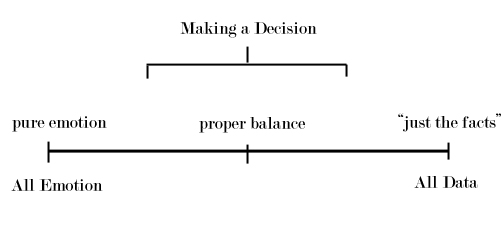Making decisions, Part 1: the spectrum of information

Making decisions
There is a spectrum of information ranging from emotions to data that the mind uses to make a decision.
On the left side of the spectrum you have pure emotions: love, peace, happiness, joy, fear, terror, anger, etc., these emotions are what makes life rich, substantive, and meaningful. On the right side of the spectrum there is pure data: facts, patterns, numbers, laws, calculations, etc., this side of the spectrum is completely devoid of emotion, and so, there is not much meaning on this side, but the reality of its information is very close to what is happening in the real world.
If you go too far to either side, you will make decisions that will be in error. You must try to find a balance between the two in order to make decisions properly.
You must have balance
If you've ever watched star trek the next generation, there was the captain making the decisions for the ship; on his right side he had data (the android that processed life as a machine) and on his left side you had diana troy (a telepath that processed life through emotions). In order to make the best decision, the captain would listen to both sides of the spectrum. He would ask data what he thought, and then he would ask diana what she thought, and then he tried to make the best decision possible given this information.
In the same way, we should make our life decisions with balance. We should get as much data and facts as possible, but we should also remember to understand our feelings and emotions. When we find the right balance, we will have harmony in our life. This is a process; sometimes we'll get things wrong, and sometimes we'll be right. But if we remain balanced, then we'll be much better off in life than if we are too far to one extreme.
Also, we must remember that the proper balance is determined individually, there is no magic ratio that works for every person. Some people start out being more emotional, some start out being more rational, the balance is dependent on the person making the decisions. But just being aware that there is a spectrum will go a long way in helping us make the correct decisions.
Imbalance in history
You can take a look at the imbalance in history as well. There was the dark ages and the cult of death in Europe. which probably was all emotional based decisions. During that time, there were no accurate maps because the people only needed a map to heaven (a very emotional reality devoid of facts). Later, there was the age of reason and the enlightenment; all decisions were to be rational and data based, which is why we enjoy so much modern technology. But at the same time, many people suffer because we have lost the meaning in life, we have lost the emotionality that gives so much to us.
Imbalance in the sexes
These are generalizations, but many women make their decisions on the left side of the spectrum. They operate in a world of emotion, which to many men, is foreign to them. Most men operate on the right side of the spectrum; they try and make rational decisions, and when a woman starts to be emotional, he'll try to stop it; if he's not strong enough, he'll be controlled by the emotion.
But this is a proper balance. You see how with both of them together, you have the full range of the spectrum in their lives. You have the right side in the man, and the left side in the woman. When they make decisions together and in context, they are more likely to have a correct decision process, but if either is too strong, then you will have disharmony.
Balance is the key.

0 Comments:
Post a Comment
<< Home